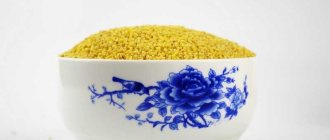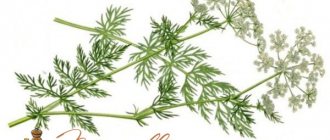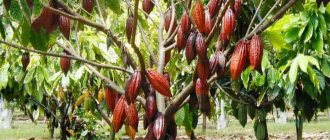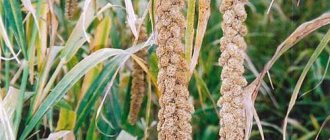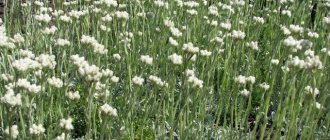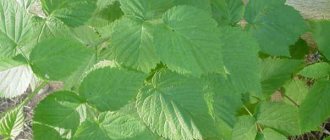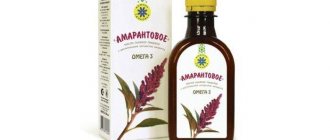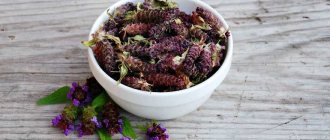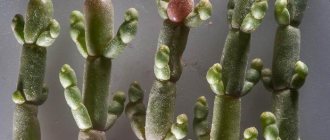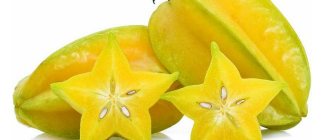Botanical description
The sainfoin grass grows up to 40-80 cm in height. It has a long taproot (sometimes up to 3 meters) and a straight, rough stem. The leaves have a complex shape - each of them is formed from 15-25 smaller leaves. Sainfoin flowers are collected in clusters or spikes and come in purple or white, yellow and pink shades. Brushes (spikelets) can reach a length of 20 cm.
Sainfoin bears fruit as beans rich in protein. Sainfoin seeds look similar to beans. They are smooth to the touch and have a yellow-green tint.
The flowering period begins in the second year after planting and lasts from the end of spring until the first days of July. Each inflorescence can last no more than a day, and usually only up to 12 hours.
Description of the plant, its varieties and botanical features
The medicinal herb belongs to the Legume family and can reach a height of 30-70 cm. The culture is beautiful, frost-resistant, prefers dry limestone soils. The flowers of the plant can be white, cream, pink, purple, red. They open sequentially and live no more than 1 day. All inflorescences disappear after 7-10 days, after which the fruits begin to ripen. Stems are straight, branched. The root system is well developed and grows to great depths. The fruits are gray-green, similar in shape to beans.
photo of a plant in its natural habitat
There are about 80 species in the wild, for example:
- Onobrychis lasiostachya Boiss (sand sainfoin). The stems of the crop are vertical, ascending, fibrous, glabrous, reaching a height of 15-20 cm. Strongly branched at the base, ribbed, fibrous. The flowers are pink, reaching a length of 7-8 mm. The bracts are lanceolate, membranous, half as long as the flower calyx. Leaves are linear-whole, fibrous.
- Onobrychis viciifolia (sainfoin). This is a legume perennial plant. The leaves are green, pinnate, paired, oblong-ovate. Flowers are bell-shaped. The stems are branched, strong, can grow up to 80 cm. The fruits are fibrous, semicircular, equipped with thorns along the edges. The roots are deep and can grow up to 4 m.
- Onobrychis pallasii (pallas sainfoin). It is a protected species and is listed in the Red Book of Crimea. Reaches a height of 80-100 cm. The leaves in the lower part are silky-pubescent, green. The flowers are large, long, with a pubescent corolla. Fruiting occurs in July-August. The culture prefers limestone, nutritious soil.
Other varieties:
- Onobrychis sibirica (Siberian);
- Onobrychis Transcaucasia Grassh (Transcaucasian);
- Onobrychis montana;
- Onobrychis inermis;
- Onobrychis vulgaris;
- Onobrychis tomentosa.
Spreading
Grows in rocky areas, meadows, and along roadsides. You can often see grass on mountain slopes, along the banks of rivers and lakes. Distributed mainly in Central and Southern Europe and Siberia.
Some species of sainfoin are native to Spain, Portugal, Tunisia, the northern part of the African continent, Australia and North America.
nature has endowed the plant with a rich chemical composition that has a positive effect on human health
Chemical composition of the herb
The plant extracts large amounts of nutrients from the soil. Many vitamins, minerals, and amino acids were found in the culture.
The above-ground part contains:
- proteins;
- carbohydrates;
- fats;
- calcium;
- phosphorus;
- magnesium;
- iron;
- ascorbic acid;
- phenolic compounds;
- sucrose;
- carotene;
- fiber;
- vitamins E, D and group B.
Where does it grow
The wild plant lives mainly in meadows, pastures, on the edges of forests and near water bodies. The sainfoin grass is found in southern Europe, northern Africa, and western and central Asia.
It is not picky about soil and can grow successfully in dry areas. This is facilitated by a powerful root system that draws moisture from deep areas of the earth. In one place, sainfoin can grow for up to 7 years.
Sainfoin is an excellent green manure. Sainfoin: description of the medicinal plant and its use
Most often, sainfoin is sown as a fodder crop, but recently gardeners have also discovered this crop. And for good reason!
Sainfoin is just that plant of the legume family that not only can, but also should be used as a green manure crop.
The properties of the plant are excellent - it grows quickly, a lot of green mass grows, the root system penetrates deeply, nitrogen accumulates 9 like other legumes)... What can I say? Sow - and enjoy the result!
What is sainfoin?
Sainfoin is a classic legume perennial. After all, it can grow in one area for several years - and at the same time produce a good amount of green mass. Beautifully blooming green mass! Sainfoin crops attract bees, which is why the crop is sown not only by livestock farmers, but also by beekeepers for maintenance honey collection. The honey plant is excellent!
Sainfoin has bright pink flowers with various shades. Forms a bush of medium thickness, 30-70 cm high. Complexly dissected leaves.
A fairly drought-resistant plant.
Winter hardiness is excellent, practically does not freeze.
Is sainfoin suitable as green manure?
Like other legume green manures, sainfoin is good in this role.
The green mass is formed quite actively, there is enough material for fertilizer!
For dense, heavy soils, an indispensable tool for improving moisture and air exchange. After all, sainfoin has a very powerful root system!
Forms of calcium and phosphorus that are difficult to obtain for other plants are quite possible for sainfoin
Plus, a feature of all legume family crops is the accumulation of nitrogen in the soil.
Growing and caring for sainfoin as a honey plant
Perennial sowing honey plants are planted mainly on those lands on which they previously grew:
- potato;
- beet;
- corn;
- after other agricultural crops, but provided that they were well fertilized.
It is not recommended to sow sainfoin after sunflower. This can be explained by the fact that the “sunny” flower leaves behind dry and dehydrated soil, which sainfoin absolutely cannot tolerate. The plant does not tolerate drought and light frosts.
If you want to grow honey plants by spring, it is recommended to prepare the soil in October. It is imperative that stones and weeds are removed from the ground, and piles of soil must be broken into small pieces. Before sowing the fodder crop (honey plant) to obtain a better harvest, the soil is fertilized, leveled and even rolled a little.
Note! It is prohibited to apply nitrogen fertilizers in liquid form, which can only harm young seedlings. Herbaceous sainfoin does not germinate in an acidic environment, since the plant’s ability to absorb nitrogen from the air is significantly reduced due to a decrease in the number of nodule bacteria that are in the soil
To prevent this from happening, it is recommended to fertilize the soil with lime.
Herbaceous sainfoin does not germinate in an acidic environment, since the plant’s ability to absorb nitrogen from the air is significantly reduced due to a decrease in the number of nodule bacteria present in the soil. To prevent this from happening, it is recommended to fertilize the soil with lime.
Before sowing, bean seeds are placed in a solution filled with useful microelements, for example, “Fundazol”. After sainfoin is sown, the soil is rolled and treated with special insecticides, which avoids the death of seeds due to small rodents.
Active flowering of the honey plant begins in the beginning or in the middle of summer only after two years of germination.
Bees are not always able to collect nectar throughout the flowering period of sainfoin, so natural sweetness rarely appears on store shelves.
Valuable honey plant
The plant is rich in honey - in just one day, bees can collect from 4 to 6 kg of honey from a hectare of blooming sainfoin. Nectar begins to release best from flowers when the air temperature reaches 22-25 degrees.
As numerous reviews confirm, sainfoin honey is distinguished by its rich aroma, taste and transparency. It remains fresh for a long time and does not become sugary. Honey contains ascorbic acid, many vitamins and minerals necessary for humans. After a certain time, it acquires a soft milky hue.
Blooming sainfoin
The brushes and bases of the branches begin to bloom first. In each brush, the opening of flowers occurs sequentially from bottom to top. 1-2 horizontal rows of flowers open daily. Sainfoin flowers bloom throughout the day. The first flowers open around 7 am, most bloom between 10-12 am, and the rest continue to bloom until 6 pm. Thanks to the exceptionally abundant nectar secretion and a large amount of pollen, almost all the flying bees brought to the apiaries for honey collection and pollination are concentrated on flowering sainfoin crops. To ensure complete pollination of crops, you need to have apiaries at the rate of four bee colonies for each hectare of crops. The honey productivity of sainfoin in Siberia under favorable conditions reaches 200 kg/ha (V.G. Kashkovsky, N.D Mashinskaya, 1985), in the European part of Russia it is 89-146 kg/ha (E.G. Ponomareva, 1980). In Altai, sainfoin blooms approximately like sweet clover and bruise on June 10-20 and fades at the end of July. In addition to nectar, bees take brown-yellow pollen from sainfoin. According to available data, bee pollen from sainfoin is dominant during its flowering period. Sainfoin has an undeniable value for beekeeping and deserves attention when organizing apiaries. Sainfoin honey is light amber in color, transparent, with a delicate taste and aroma. Does not crystallize for a long time, suitable for wintering bees. It crystallizes into a white fat-like mass with a creamy tint. Refers to the best varieties of honey.
Forage plant
The described plant is also a valuable green food for animals - it makes excellent hay, since it is not afraid of frost and is well preserved in different weather conditions. Farmers claim that animals that eat sainfoin are not prone to disease.
In addition, sainfoin is a high-yielding grass that produces several cuttings per season. This allows you to make good reserves of hay for the winter.
Types of sainfoin
Today, the following types of sainfoin (legume family) are distinguished:
- Transcaucasian.
- Sandy.
- Vicoleaf (sowing).
- Hybrids.
The most common plant today is sainfoin, the crops of which occupy the majority of sainfoin crops in general in the CIS countries. If favorable conditions are provided, it is possible to grow a honey plant up to 80 cm in height. The flowers of the plant are bright, reddish, pinkish and with dark stripes. Distinctive characteristics of the plant:
- the ratio of leaf mass to the total weight of the ground part is 40/100;
- only in the second year the fruits of the plant are formed;
- has single-cut forms of winter type.
Sandy sainfoin is considered a more adapted crop to weather conditions. The plant tolerates drought and light frosts well, and the flower itself is not affected by rodents and diseases. This honey plant is sown with alfalfa and awnless rump. Honey from such fields will contain admixtures of other plants and a smaller proportion of the main honey plant. The plant blooms mainly in May or June. Distinctive features of the plant:
- maximum height of honey plant 60-100 cm;
- considered more adapted to different climatic conditions;
- the inflorescence is a long and thin raceme.
Transcaucasian sainfoin is characterized by rapid growth (up to 6-10 days), high drought resistance and winter hardiness. This species can be recognized among others by its rough trunk and weak foliage. A good nectar-bearing flower allows you to get up to 90 kg of honey from just one hectare. You can find honey plants mainly in Transcaucasia and the North Caucasus. Main characteristics of the plant:
- leaves are gray-green and bluish in color, ovoid;
- inflorescences in the form of dense brushes;
- stem height 140-150 cm.
The plant is used as feed for farm animals or as a fallow crop. However, sainfoin is also often used as a honey plant.
Useful properties of sainfoin
The part of the plant that grows on the surface contains many useful substances. These are fatty oils, sucrose, proteins, ascorbic acid, enzymes, carbohydrates, carotene and fiber. Also, sainfoin herb is saturated with flavones, substances with anti-inflammatory properties. They strengthen the walls of blood vessels, which is why this herb is often used during the treatment of cardiovascular diseases and cancer.
The nitrogen-free compounds included in its composition can also normalize the activity of the gastrointestinal tract, reduce blood sugar and cholesterol levels, and improve the function of absorption of nutrients from consumed foods.
Ascorbic acid helps increase the human body’s resistance to various types of infections, strengthens the central nervous system, normalizes metabolism, and helps to recover after intense training.
Sainfoin is a herb that contains the vitamin rutin, which the human body is not capable of producing on its own. It helps reduce blood clotting, increases the elasticity of red blood cells and reduces capillary fragility.
Composition of sainfoin
The leaves, stems and flowers of the medicinal plant contain:
- ascorbic acid;
- fixed oils;
- fiber;
- rutin and carotene;
- flavonoids;
- amino acids;
- sucrose and raffinose;
- carbohydrates and proteins;
- iron and magnesium;
- phenols;
- phosphorus and calcium;
- B vitamins;
- tocopherol;
- vitamin D
Basically, the sainfoin plant is used in dried form; properly prepared raw materials retain all the beneficial properties. But fresh plant juice from stems and leaves is also valuable.
Sainfoin - medicinal plant
With the help of sainfoin, men produce testosterone and androgens, which has a good effect on male sexual function. According to reviews of patients who used the medicinal plant, their sexual intercourse and erection normalized, libido levels increased and ejaculate production increased. Women also praise the properties of sainfoin as an excellent aphrodisiac - it can increase the sensitivity of intimate areas and inflame desire.
Sainfoin is a multifunctional tonic. It is used to protect against infectious diseases and in the treatment of diabetes. It is also used to treat uterine bleeding, problems with the ovaries, normalization of the menstrual cycle, hormonal levels, during menopause and in the period before the onset of menopause. It is also used for pain during menstruation.
Sainfoin helps in restoring and improving the functions of the intestines and stomach. Also, a herbal decoction from it is often used for cosmetic procedures. And the honey of this herb is used for peelings, face masks and strengthening hair.
Useful properties of the plant and contraindications to it
Infusions and decoctions from the plant will help restore strength in the following diseases:
- impotence;
- kidney disease;
- menstrual irregularities;
- uterine bleeding;
- diabetes;
- anemia.
A contraindication to the use of this plant is an allergic reaction to honey. Before using the product, it doesn’t hurt to do a skin test by smearing it on your wrist. If after this a rash appears on it, then sainfoin honey should not be consumed.
Growing sainfoin
Sainfoin is good to grow in multi-field fodder. Precursors recommended for the plant are corn, potatoes, beets, as well as crops that were grown with organic fertilizers. The soils on which sunflowers were grown are not suitable for growing sainfoin, since such a plant dries out the soil.
For proper cultivation of sainfoin, soil cultivation technology is especially important. It consists of leveling the top layer of soil, pre-sowing and post-sowing compaction. Before you start sowing, you need to make sure that the area is free of weeds, thoroughly leveled and there are no large lumps of earth on it.
If it is necessary to obtain a high yield, it is important to fertilize the previous soil (poor) with organic fertilizers. Dosage ranges from 60 to 80 kg/ha
For nitrogen fertilizers, the numbers are different: for annual grasses – 30–45 kg/ha, for barley – 40–50 kg/ha. The use of liquid forms of nitrogen fertilizers is prohibited, as their use can damage the seedlings. Phosphorus and potassium fertilizers are useful.
Acidic soils are undesirable for sainfoin, since nodule bacteria develop poorly in them, as a result of which the absorption of nitrogen from the air by plants is significantly reduced. Therefore, it is recommended to pre-lime acidic soils. Sainfoin seedlings do not respond well to shade; in addition, they need cover crops (winter grains, spring crops, green fodder, annual grasses), which are harvested early for fodder.
Growing sainfoin
Sainfoin is good to grow in multi-field fodder. Precursors recommended for the plant are corn, potatoes, beets, as well as crops that were grown with organic fertilizers. The soils on which sunflowers were grown are not suitable for growing sainfoin, since such a plant dries out the soil.
For proper cultivation of sainfoin, soil cultivation technology is especially important. It consists of leveling the top layer of soil, pre-sowing and post-sowing compaction. Before you start sowing, you need to make sure that the area is free of weeds, thoroughly leveled and there are no large lumps of earth on it.
If it is necessary to obtain a high yield, it is important to fertilize the previous soil (poor) with organic fertilizers. Dosage ranges from 60 to 80 kg/ha
For nitrogen fertilizers, the numbers are different: for annual grasses – 30–45 kg/ha, for barley – 40–50 kg/ha. The use of liquid forms of nitrogen fertilizers is prohibited, as their use can damage the seedlings. Phosphorus and potassium fertilizers are useful.
Acidic soils are undesirable for sainfoin, since nodule bacteria develop poorly in them, as a result of which the absorption of nitrogen from the air by plants is significantly reduced. Therefore, it is recommended to pre-lime acidic soils. Sainfoin seedlings do not respond well to shade; in addition, they need cover crops (winter grains, spring crops, green fodder, annual grasses), which are harvested early for fodder.
Description and photo
The tap root goes deep into the ground, making it resistant to drought and undemanding to soil fertility. Beautiful bright pink spike-shaped inflorescences bloom in June - July, the pink field of blooming sainfoin is a wonderful sight.
The seeds ripen in early autumn; they are light brown, flattened, in a dense wrinkled shell, similar to small turtles. In one place the culture can grow up to 7 years.
Three types of sainfoin are cultivated:
- sandy,
- sowing,
- Transcaucasian
More productive hybrids have been bred based on these species.
- The sowing or vicoleaf variety is the most common in cultivation; it produces an early and abundant harvest, 2 weeks ahead of other types. Quite sensitive to lack of moisture in the soil.
- The Transcaucasian species is the best honey plant and is an essential component of grass mixtures sown in fields for bees. Widely used in crops in the Caucasus, Rostov and Volgograd regions.
- Sandy sainfoin is surprisingly unpretentious, extremely winter-hardy and grows well without watering. Its disadvantage is that its stem becomes coarser early, which is why you should not be late in mowing the greenery.
It is also of great economic importance: it is a wonderful fodder and honey crop. Rich in nutrients and vitamins, sainfoin is sown to produce hay and grass meal for livestock. From one hectare of flowering plants, bees are able to collect 5–6 kg of fragrant, healing honey in one day, and in just one season the harvest can amount to up to 400 kg.
Varieties of sainfoin
Transcaucasian sainfoin, compared to other species, brings the most harvest. It is resistant to drought and frost, grows quickly after mowing, two and sometimes three mowings can be achieved in one season. This variety is planted mainly in the North Caucasus and Transcaucasia.
Sandy sainfoin got its name because it can grow on any soil, including sandy soil. It is resistant to drought and frost. The disadvantages of sandy sainfoin are its rough stem and small number of leaves. In modern culture, hybrid varieties of this plant are popular.
Seed (vicofolia) sainfoin is one of the most common varieties; it ripens earlier than all cultivated cultivated species by 1.5–2 weeks. Sown sainfoin, unlike its relatives, does not tolerate cold and drought well and produces one cutting per season.
Sainfoin sativa.
Due to its composition, the plant is used by traditional healers to treat disorders of the sex glands (impotence in men or menstrual irregularities in women), and uterine bleeding. Infusions and decoctions based on it are recommended to increase immunity, for the treatment of diabetes, and also as a tonic. Sainfoin helps lower blood cholesterol levels and increases hemoglobin levels.
Sainfoin
Sainfoin is a perennial forage and melliferous plant from the legume family; grows in one place for three to seven years. It works well on chernozems, as well as on soils with a high content of lime and marl.
img62Brightly colored (pink or red) sainfoin flowers, collected in conical racemes, bloom early, soon after the gardens have faded; Flowering lasts for 3-4 weeks.
Sainfoin flowers are readily visited by bees throughout the day and produce high-quality light honey with a pleasant aroma. Pollen is brown-yellow.
The honey productivity of sainfoin varies greatly: in the central black earth regions, Ukraine and the south of the RSFSR, the honey yield from sainfoin reaches 120 kg, and in the southeast of Kazakhstan - only 70 kg per hectare. Transcaucasian sainfoin is extremely valuable for beekeeping, especially when irrigated.
Under favorable conditions, its honey productivity reaches 400 kg. per hectare!
Sainfoin flowers are collected in fairly compact inflorescences - racemes (Fig. 26). The individual flower consists of a five-toothed pale green calyx, a bright pink corolla (pale pink to pinkish red in some varieties) of the moth type, a single fruit and ten stamens (of which nine are fused). The nectar-bearing tissue looks like a flat glandular ring and is located under the ovary between the circle of stamens and the fruit. The released nectar enters the arch of the sail, accumulating here in large quantities. The nectar is colorless, only slightly cloudy in large portions, the average sugar content in it is 46.4% (with fluctuations from 37.2 to 55.6%).
Nectar begins to be released from the moment of flowering, as soon as the corolla opens, and the more often and more intensively insects (honey bees) select it from the flowers. The brushes at the base of the branch begin to bloom first, and inside each brush the flowers also open from bottom to top. 1-2 horizontal rows of flowers open daily.
Usually flowers that bloom in the morning have already withered by the evening of the same day or by the morning of the next. Flowers that open in the evening remain for 24 hours. In unfavorable weather that prevents the flight of insects, wilting may be delayed for 1-2 days. The entire brush fades in 2-8 days. It is characteristic that the anthers wither first, the stigma of the style remains fresh for some time.
The structure and mechanism of the sainfoin flower are well suited for cross-pollination. Due to the exceptionally abundant nectar secretion and large amount of pollen, almost all the flying bees of the apiaries brought for honey collection and pollination are usually concentrated on flowering sainfoin crops. This is especially noticeable at the height of sainfoin flowering, when the youngest and largest flowers of the lower tiers with large honey glands that exude a lot of nectar are functioning. According to the observations of A.K. Tereshchenko, at the Kharkov (now Ukrainian) beekeeping experimental station at this time, sainfoin is visited by up to 95% of the working bees and only 5% of them are visited by other honey plants, including those known for their nectar production, cress, bruise, and sweet clover. yellow, meadow bark, etc.
But it must be taken into account that this fact occurs only when the apiary is brought close to the sainfoin tracts. The number of bees in a crop will invariably fall as the distance they must travel when leaving the hives increases. And the greater this distance, the smaller the seed yield in this area. In addition, another factor will be important here, namely the number of bee colonies being transported and their strength.
Sainfoin develops a huge number of flowers, and its flowers must be visited more than once. Based on this, it is calculated that for complete pollination of 1 hectare of seed crops, at least 3-4 strong bee colonies are required. The placement of apiaries should ensure that the bees are distributed as evenly as possible throughout the crop. On very large areas, apiaries should be located no further than 1.5 km from one another. With a smaller sowing area, the apiary is placed in the center of the array or in close proximity to it.
If the weather is favorable, strong families collect 4 kg of honey from sainfoin every day. Sainfoin flowers secrete nectar most intensively at a temperature of 22-25° C. Wide-row crops secrete more nectar than ordinary ones. The nectar productivity of 1 hectare of sainfoin can vary from 63 to 102 and even up to 282 kg and is determined mainly by the number of flowers on the plants, which depends on agricultural technology, meteorological conditions, cultivation zone, timing of cutting for hay and other reasons.
Honey from sainfoin is beautiful, light amber, transparent, feces crystal, aromatic and pleasant to the taste, it does not quickly become candied. In crystallized form, it is a white solid mass with a creamy tint, reminiscent of lard. To increase the marketable yield of honey from sainfoin, the apiary must be specially prepared for the beginning of flowering. The early flowering of sainfoin usually coincides with the period of brood rearing in bees, and a significant proportion of the collected honey is used to feed it.
Sainfoin works best on marl and calcareous soils with the same subsoil. For bees, sainfoin can also be profitably grown on non-crop lands, abandoned and wasteland areas, hillsides, landslides, rocky and barren places unsuitable for the cultivation of clover and alfalfa, as long as there is suitable subsoil and reliable snow cover in winter.
If special areas are not allocated for sainfoin crops in crop rotations, then it can be used in mixed crops. For example, in 1963, the Issyk-Kul Experimental Selection Station of the Tyup Production Department used sainfoin to obtain a triple harvest from one field; combined sowing of peas, fodder beans and sainfoin was tested. An area of 10 hectares was sown with peas and broad beans (alternating them every 4 rows). Sainfoin was sown under the cover of these crops. The result was good. The beans protected the peas well from lodging, and row sowing prevented the stems from intertwining, which made it possible to mechanize harvesting. Sainfoin sown on the same area did not occupy a special place in the crop rotation, did not displace grain crops, and, in addition, additional high-protein feed was obtained for dairy cattle. From each hectare we received about 350 centners of highly nutritious green mass and up to 45 centners of legume grain. Two months after mowing, sainfoin yielded about 70 quintals of silage, or 20 quintals of hay per 1 ha. Finally, the presence of this forage grass made it possible for honey bees to take advantage of the rich bribe from it.
Sainfoin can be successfully cultivated in Ukraine, partly in the Rostov region, in the foothills of the North Caucasus and in Transcaucasia. The southern regions of the Voronezh region, a significant part of the Volga region, Kharkov and other regions are also suitable for its cultivation.
Sainfoin is best sown on southern, warm and sunny slopes. Tillage of the soil for sainfoin is carried out to a depth of at least 20-22 cm. It is necessary to plow in the plowed land and leave the field unharrowed. Sainfoin is sometimes sown on prepared soil in its pure form, but, as a rule, in a mixture with spring cover plants (oats, wheat).
Sainfoin for silage or hay should be removed at the beginning of flowering. This helps the sainfoin stay in one place longer. For beekeeping, seed sowings of sainfoin are most beneficial, since the honey flow from it in these cases covers the entire flowering period.
Among the Transcaucasian forms of sainfoin, attention should be paid to the Azerbaijani sainfoin, which has hollow stems, reaches a high growth and produces at least two cuttings. This species is very drought-resistant; it can become a promising crop for the regions of the Ciscaucasia, Rostov region, Stavropol Territory and partly the Volga region.
Use of sainfoin
Among all the perennial herbs, sainfoin has been little studied as a medicinal plant. In Germany and Italy, the culture was used from the 17th - 18th centuries. when raising livestock. In Russia, it began to be used in 1801 as a good fodder plant for horses.
Currently, farmers value the grass because it is readily consumed by cattle. Sheep love to eat the leaves, stems and buds of the plant, and pigs consume large quantities of even its tough shoots.
Sainfoin is considered a good forage plant for horses.
Green food is served to poultry in crushed form.
Honey - sainfoin is quite high in calories, but can be included in the diet even for diabetics. Sweet tooth lovers will appreciate its light amber color and aromatic smell while guaranteeing the avoidance of hypoglycemic coma.
It is also useful in making nourishing and moisturizing masks for the face and hair.
Sainfoin as a green manure is successfully used as an organic supplement
It is only important to fertilize the previous soil in order to then obtain humus, saturated with phosphorus and nitrogen to nourish the soil when planting other plants
Extracts of the flowers and leaves of this plant produce excellent ingredients for creating elegant scents. The French brand Oriza L. Legrand, which was preferred by Louis XV, produces unisex eau de toilette based on sainfoin.
Sainfoin nectar is produced at an air temperature of 22 °C
